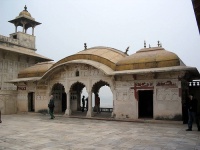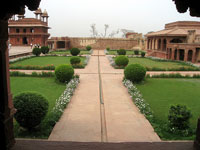Things to do in Agra
Situated in an overwhelmingly noisy and dirty city, the attractions in Agra are nevertheless some of the most famous and beautiful in the world. Most people visit Agra primarily to see the Taj Mahal, and this glowing white monument more than justifies the trip all by itself.
No matter how jaded or disenchanted a traveller is, the Taj conjures deep emotions; it is almost impossible not to be moved by the love story that birthed this splendid mausoleum. Even for those who don't like the soppy stuff, the beauty of the building is mesmerising. It is India's most popular and iconic attraction, and one of the most recognisable buildings in the world. Travellers can expect it to be busy no matter when they visit! To admire the Taj Mahal from a distance, and escape some of the crowds at the site, travellers should pay a visit to the Mehtah Bagh gardens, where they can relax on the lawns and take photographs. The gardens are not exceptional, but the views are.
Another world-class attraction in the city, very near the Taj Mahal, is the Agra Fort, a 16th-century Mughal monument containing a veritable treasure trove of impressive buildings. Things to see in the fort include the Jahangir Palace, the Khas Mahal, the Glass Palace (Sheesh Mahal), which is inlaid with thousands of mirrors, and two stunning mosques. Shah Jahan spent the last seven years of his life incarcerated in the ornately carved Octagonal Tower, which once had an enviable view of his beloved Taj Mahal.
A less famous but very worthwhile site, the Tomb of Itimad-ud-Daulah is one of the best things to see in Agra. It is often called the mini-Taj and, although it is small, it is exquisitely carved and consistently ranks with visitors as one of Agra's great treasures. The attraction is usually quiet and seldom crowded, and its peaceful atmosphere is refreshing compared to the bustle of other attractions in Agra.
Those who have time to adventure out of the city should consider an excursion to Fatehpur Sikri, a medieval fortress that was briefly the capital of the Mughal Empire, but was deserted in 1585 due to water shortages. This proud fortress now stands, perfectly preserved and a little spooky, in the arid landscape 25 miles (40km) west of Agra.

Taj Mahal
The Taj Mahal is one of the world's most recognisable and evocative sights. Set overlooking the River Yamuna and visible from Agra Fort in the West, the Taj was built by Shah Jahan…
Taj Mahal
The Taj Mahal is one of the world's most recognisable and evocative sights. Set overlooking the River Yamuna and visible from Agra Fort in the West, the Taj was built by Shah Jahan to enshrine the body of his favourite wife, who died giving birth to her 14th child in 1631. When his devout and austere son Aurangzeb seized power, Shah Jahan was interned in Agra Fort, where he lived out his final years gazing wistfully at the Taj Mahal in the distance. When he died there in January 1666 with his daughter Jahanara Begum at his side, his body was carried across the river to lie alongside his beloved wife in the peerless mausoleum.
Website www.tajmahal.gov.in

Agra Fort
Not far from the gardens of the Taj Mahal stands the important 16th-century Mughal monument known as the Red Fort of Agra. This powerful fortress of red sandstone encompasses the i…
Agra Fort
Not far from the gardens of the Taj Mahal stands the important 16th-century Mughal monument known as the Red Fort of Agra. This powerful fortress of red sandstone encompasses the imperial city of the Mughal rulers within its 1.5 mile-long (2.5km) enclosure walls, and comprises many fairytale palaces. These include the Jahangir Palace and the Khas Mahal, which was built by Shah Jahan; audience halls such as the Diwan-i-Khas; and the Sheesh Mahal (The Glass Palace), which is inlaid with thousands of mirrors and was once the harem dressing room. There are also two beautiful mosques, including Shah Jahan's Pearl Mosque.

Fatehpur Sikri
The deserted city of Fatehpur Sikri was the capital of the Mughal Empire between 1570 and 1585. It was built under the personal supervision of the Emperor Akbar. The story goes tha…
Fatehpur Sikri
The deserted city of Fatehpur Sikri was the capital of the Mughal Empire between 1570 and 1585. It was built under the personal supervision of the Emperor Akbar. The story goes that the emperor was childless and, having tried all sorts of solutions to his plight, visited a Sufi saint, Sheikh Salim Chishti, for help. Soon a son was born, and Akbar started building on the site where he had met the saint. However, due to a severe shortage of water the city was abandoned after only fifteen years, and the capital was relocated back to Agra. Today Fatehpur Sikri is an untouched and perfectly preserved medieval fortress.



